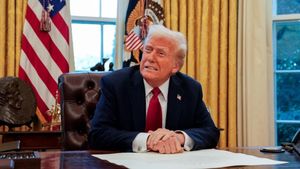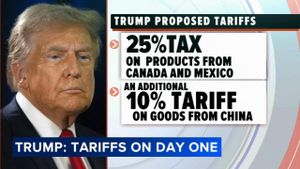President Donald Trump’s recent memorandum advocating for the expansion of migrant detention operations at Guantanamo Bay has ignited widespread outrage among human rights activists, legal experts, and advocates for immigrants. The controversial plan aims to detain up to 30,000 undocumented immigrants at the naval base known for its association with notable human rights abuses and torture.
On January 31, 2025, Trump issued directives to the Pentagon and the Department of Homeland Security to prepare for detaining large numbers of migrants considered "high-priority criminal aliens" unlawfully present within the United States. This initiative aligns with his administration's broader agenda of rigorous immigration enforcement and mass deportations.
Trump justified his proposal by asserting, "We have 30,000 beds in Guantanamo to detain the worst criminal illegal aliens threatening the American people." This narrative emphasizes his administration's focus on criminalizing undocumented immigrants. Nonetheless, critics argue the characterization of these individuals as criminals reflects the continuation of anti-immigrant sentiment and policies.
Pardiss Kebriaei, a staff attorney at the Center for Constitutional Rights, expressed her alarm, emphasizing the historical failures and abuses associated with the Guantanamo detention center. "We should all be disturbed by the use of Guantanamo to send a chill down people’s spines ... I can’t think of another infamous prison where a leader of the country would capitalize on brutality and torture, as a threat," Kebriaei commented.
The very idea of using such facilities for mass detaining migrants presents logistics and human rights issues. Reports highlight past conditions at the Guantanamo detention center, known for its substandard environment, lack of hygiene, and absence of oversight. This backdrop raises questions about the plausibility of providing humane living conditions for such massive numbers of detainees.
Attorneys who have advocated for individuals previously incarcerated at Guantanamo are also sounding alarms about this new plan. "The offshore nature of Gitmo opens up the ability for the administration to even entertain those arguments," Kebriaei elaborated, alluding to potential legal ramifications concerning the constitutional rights of detainees.
Alongside the detention plan, the signing of the Laken Riley Act—a law mandatorily detaining immigrants accused of even nonviolent crimes—exacerbates concerns. This legislation aims to strengthen Trump's immigration crackdown, but critics, including the American Civil Liberties Union, argue it stigmatizes immigrants and could lead to chaotic courtroom scenarios.
Anthony Scaramucci, former White House communications director, described Guantanamo as nothing less than "a concentration camp," calling on lawmakers to address these alarming developments. The use of Guantanamo Bay for detaining immigrants not only raises moral questions but could also provoke nationwide protests reminiscent of those seen historically from refugees detained under similar circumstances around the 1990s.
The vast majority of legal experts contend the proposed migrant facility presents challenges, not only logistically but also ethically. For decades, Guantanamo has remained emblematic of the U.S. government's tendency to operate outside public scrutiny, often excusing human rights violations framed within the so-called "war on terror." Despite its notorious past, Trump’s memorandum indicates there are plans to make it even more central to his immigration enforcement strategy.
Despite the backlash, Trump’s administration has continued to push forward, leveraging what they view as necessary measures to curb the perceived immigration crisis. The administration promised to arrest upwards of 1,200 individuals daily, signaling their intent to heighten the overall pressure on immigrant communities, particularly targeting groups identified through racial and ethnic profiling.
Even as this administration's plans develop, many experts worry about the potential fallout stemming from its controversial nature. The prospect of detaining thousands of people at Guantanamo could lead to international condemnation, legal challenges, and severe ramifications for long-standing U.S. immigration laws, which could reverberate within the courts and among communities.
Further complicate the situation, the Cuban government, which has maintained its opposition to the U.S. military base on its territory, warned of serious “risks and insecurities” if such large-scale detentions were to occur. The prospect of using Guantanamo for immigrants seemed to be politically expedient for Trump at this moment but fraught with potential obstacles.
The future remains uncertain as this plan evolves. With historical and modern-day concerns surrounding detention facilities, it poses serious ethical questions awaiting answers. With public pressure mounting from both legal bodies and advocacy groups, the Trump administration's immigration agenda could soon face significant pushback.
From unprecedented actions aimed at heightened detentions to the infamous legacy of Guantanamo Bay as part of the U.S. strategy, the immigration debate continues to play out against the backdrop of both human rights and legal imperatives. If history teaches us anything, it’s the importance of scrutiny when fundamental rights are at stake.



